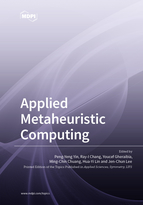Topic Menu
► Topic MenuTopic Editors





Applied Metaheuristic Computing

A printed edition is available here.
Topic Information
Dear Colleagues,
For decades, Applied Metaheuristic Computing (AMC) has been a prevailing optimization technique for tackling perplexing engineering and business problems, such as scheduling, routing, ordering, bin packing, assignment, facility layout planning, among others. This is partly because the classic exact methods are constrained with prior assumptions, and partly due to the heuristics being problem-dependent and lacking generalization. AMC, on the contrary, guides the course of low-level heuristics to search beyond the local optimality, which impairs the capability of traditional computation methods. The most commonly used AMC methods include:
- Ant colony optimization;
- Differential evolution;
- Evolutionary computation;
- Genetic algorithm;
- GRASP;
- Hyper-heuristics;
- Memetic algorithm;
- Particle swarm optimization;
- Scatter search;
- Simulated annealing;
- Tabu search;
- Variable neighborhood search.
I encourage the submission of your best papers within the topic of AMC.
Prof. Dr. Peng-Yeng Yin
Prof. Dr. Ray-I Chang
Dr. Youcef Gheraibia
Prof. Dr. Ming-Chin Chuang
Dr. Hua-Yi Lin
Prof. Dr. Jen-Chun Lee
Topic Editors
Participating Journals
| Journal Name | Impact Factor | CiteScore | Launched Year | First Decision (median) | APC |
|---|---|---|---|---|---|

Applied Sciences
|
2.7 | 4.5 | 2011 | 16.9 Days | CHF 2400 |

Symmetry
|
2.7 | 4.9 | 2009 | 16.2 Days | CHF 2400 |

International Journal of Financial Studies
|
2.3 | 3.2 | 2013 | 27.6 Days | CHF 1800 |

MDPI Topics is cooperating with Preprints.org and has built a direct connection between MDPI journals and Preprints.org. Authors are encouraged to enjoy the benefits by posting a preprint at Preprints.org prior to publication:
- Immediately share your ideas ahead of publication and establish your research priority;
- Protect your idea from being stolen with this time-stamped preprint article;
- Enhance the exposure and impact of your research;
- Receive feedback from your peers in advance;
- Have it indexed in Web of Science (Preprint Citation Index), Google Scholar, Crossref, SHARE, PrePubMed, Scilit and Europe PMC.

